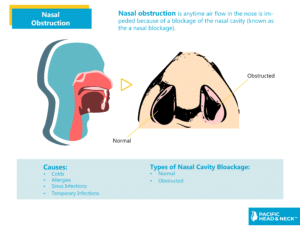Nasal obstruction is a symptom rather than an actual condition, which can be caused by medical conditions such as infection or allergies, or may indicate a structural abnormality, such as nasal septal deformity, nasal polyps, or a problem with the turbinate bones.
Nasal obstruction cases may include:
- Deviated Septum Treatment
- Turbinate Hypertrophy
- Septoplasty Turbinoplasty Reduction / Coblation Turbinoplasty

Diagnosis
The nasal septum is the separation between the two nostrils. In adults, it is composed of both cartilage and bone. The nasal septum has three functions: support the nose, regulate air flow, and support the mucous membranes of the nose. A deviated septum is a common condition that involves a displacement of the septum, the wall that separates the nostrils, to one side of the nose. The septum is usually straight at birth, but may bend to one side or the other as the patient ages. Trauma can also affect the deviation of the septum, but many patients experiencing symptoms from this condition have no history of injury.
Deviated septum makes one nasal passage smaller than the other, which can affect breathing if the displacement is great enough. Those with only minor displacement may not even be aware that they have a deviated septum and experience no symptoms.








